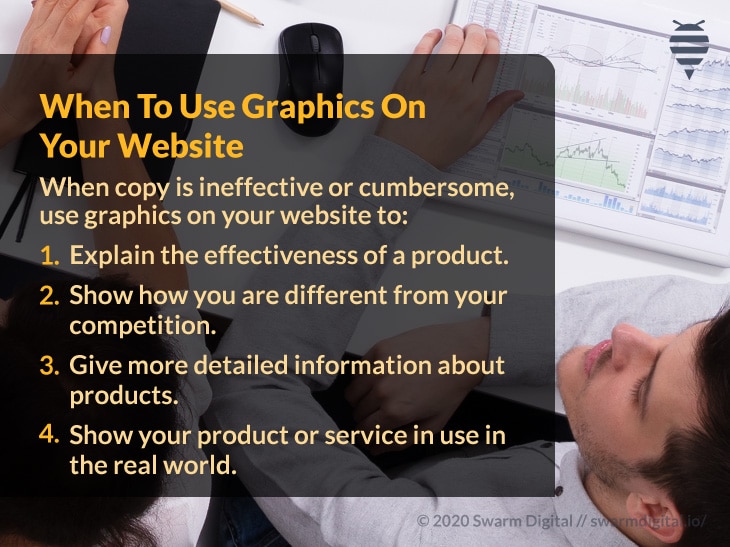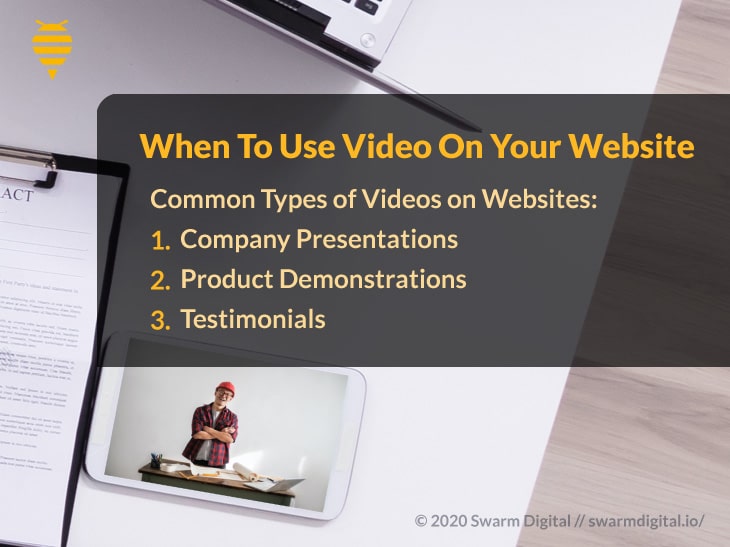When Should I Use Copy, Graphics, and Video on My Website?
- September 23rd, 2020
-
Marketing
Web
- David Fugit

The article below explains when and how to use copy, images, and videos on your website. We hope that you will find it helpful.
Due to the past COVID situation and the cautions required for in-person contact, most consumers are turning online for information, research, and sales.
Having an engaging website requires having a variety of media available to keep consumers’ attention while browsing information topics, product information, and content.
Know When to Use Copy, Graphics and Video – Three Topics
- When to Use Copy on Your Website
- When to Use Graphics on Your Website
- When to Use Video on Your Website
When Should You Use Copy On Your Website?
Website copy draws visitors to your site through search engines, gives them information on the products or services you sell, and informs them about what differentiates you from the competition. Copy is often the best way to communicate information and ideas. When text works well, we recommend using it. As a general rule, use images and videos only when the information presented would require a great deal of writing.
Some companies will find it useful to hire professional copywriters to provide content for their websites. There are advantages to this method when time is short, and the need for accurate, clear writing is critical.
As an expert in your service or product, you may choose to write the copy needed for your website. You may find it helpful to review our previous Swarm blog article, How to Write Copy for Your Website, if you feel that your technic could use some brushing up.
Below are some examples of copy commonly found on websites.
- Text on Pages
- Blogs
- Social Media
- Product Descriptions
- Advanced Content (descriptive guides, articles, and eBooks)
Good website copy directs people to buy or engage with the company. Excellent website copy inspires people to change their lives by inviting them to purchase or experience the product or service that you are selling.

There are two critical components of compelling website copy:
(1) SEO
If your business relies on your website, then you need SEO.
SEO helps you show up online when people search for your products or services on Google, or other search engines, like; Alexa, SIRI, Google Assistant, Bing, and Cortana. Search Engine Optimization (SEO) focuses on techniques to help you rank organically with keywords relevant to the products and services you offer.
We have developed a proprietary WordPress plugin called “SwarmSEO” that automates the creation of SEO landing pages for every city and neighborhood you want to target and drives those local visitors to your website. If you feel that SwarmSEO would be helpful for your business, we would be happy to talk further.
(2) Writing For the Consumer
While SEO is vital for driving people to your website, writing copy in a style that is easy to read and appeals to the user is also critical. The humans who visit your site process things differently than AI and machine learning. They have questions about your products or services for which they need answers. By adding engaging, effective copy to your website, you can answer their questions and influence them to become involved with your company.

Text on Pages
Most websites include pages that are not product pages. These may have information about the company (About Us pages), a mission statement highlighting a social or ecological consciousness, or other types of content.
Copy is essential in these cases because it explains the value of engaging with your company. Consumers often have questions about the companies with which they are considering doing business. These questions may be like the following.
- What does your company stand for?
- How will you solve my problem?
- Who is your company?
- What does your company sell?
- What do I need to know before engaging with your brand?
There are many different “markets” that find themselves online. Copy that resonates with an ecologically-conscious group may not translate well to gamers. Each market has unique qualities, and the text must be active in reaching your target market. By giving answers to common questions, your website copy can increase the bond between you and your customers, inviting them to participate in your vision.
Blogs
Blogs offer information in a conversational tone rather than an informative one. They are often written similar to a journal or diary and are highly engaging. This type of website copy is most effective in sharing information in a personal manner.
Blogs can also help your website visitors feel like they are not alone in their struggle. For example, a company selling rain boots might blog about how difficult the rainy season is in their area. By describing the difficulties they face finding proper footwear, they help website visitors feel heard and understood. By including in the blog how excellent these new rain boots are, customers are given a solution to their problem and invited to purchase the product.
Social Media
Almost half of the world engages in social media, making it the most popular form of online content. Every business can find a way to leverage social media’s power and scope by adding updates to their website. Popular social media sites include:
- Snapchat
- TikTok
These sites make it easy to post quick updates and reach hundreds or even thousands of people in mere moments. By leveraging an active social media following, you can draw people to your website. Linking to your page and posting social media updates on your site can help increase engagement and promote your company’s unified presentation online.
Product Descriptions
You’ve added pages describing your company, started a blog, and regularly post updates from your social media accounts. Visitors who come to your site are engaged and want to buy your products or participate in your service. How can you help them?
Have thorough product descriptions. Detailed information written in an engaging style is essential for the customer. Product descriptions must be accurate, or customers will find themselves disappointed with the difference between the description and the actual product or service. Use specific, easy-to-understand product descriptions on your website product pages.
It is also helpful to consider what you – as the expert – know about your product or service that your customers do not. By informing them about important information they may be unaware of, you can build trust and become an authoritative reference.
Advanced Content
Advanced content in the form of descriptive guides, articles, and eBooks further engages customers to understand the products or services you offer.
These forms of advanced content are often more time-consuming to produce and must be high quality for people to find value in them.
1 – White Papers
This type of copy is highly researched and persuasively written by a highly trained professional who understands the details of the market. White papers are advanced guides for problem-solving and often involve technical data and research. They offer a question and then provide an in-depth solution to the problem.
2 – Guides
Sometimes customers know what they want, but often they only know the problem that needs fixing. Descriptive guides can help your website visitors figure out the solution they need and understand how you can provide it.
3 – Articles
Using scholarly or journalism articles on your website can provide value and credibility to your company. When customers see that you are well known and thoroughly understand the product or service that you are selling, you gain their trust. This trust often translates directly to sales and repeat customers.

When To Use Graphics On Your Website
A common phrase that marketers use when explaining graphics’ importance is “a picture is worth a thousand words.” Images on your website are eye-catching and much easier to digest than extended descriptions and long information paragraphs.
When using images, fill out the image’s metadata properly (alt and title attributes), and consider also including nearby text and a caption to explain what the picture or video demonstrates. The additional copy and metadata will also help individuals with slower internet connections that do not load images well or whose ad blockers may filter out images and videos. Many web browsers also have a reading mode, which filters out unnecessary images for clearer, more comfortable reading. If there is important information missing from the text, it may also be missed by the customer.
When copy is ineffective or too cumbersome, it is a good idea to incorporate graphics on your website to:
- Explain the effectiveness of a product.
- Show how you are different from your competition.
- Give more detailed information about products.
- Show your product or service in use in the real world.
Images and graphics should not slow down your website or be unnecessarily large. Add text to images to clearly identify where visitors can click to see more or enlarge to show detail.
Try not to use graphics and images that look like ads. People often avoid anything that resembles an advertisement, assuming that ads distract from more valuable information. Choose meaningful images that provoke emotion and add atmosphere to your website.

When to Use Videos and Why They Are Important
If a picture is worth a thousand words, a video is worth many more. Videos are one of the most highly engaging forms of content available online. Videos show the real-life value of products and accurately depict how to use products far better than simple images. Product videos are also very good at explaining in-depth features and technical components of complicated features. A short video can accurately take the place of many paragraphs of text or complicated graphics.
It is worth mentioning again that videos (and images) should only be used when text cannot suffice. Search engines do not index video content, so websites with little text and information primarily found in graphics and videos will have low SEO scores and reduced traffic.
If you find it necessary to add videos to your website, here are a few ways to use them effectively.
Common Types of Videos on Websites
- Company Presentations
- Product Demonstrations
- Testimonials
Videos help you stand out in the crowd and attract much attention. It is estimated that less than half of company websites include videos.
Google and other search engines rank websites higher based on the amount of time people spend on the site. You can often keep people’s attention longer by adding short videos to your site. Up to 90% of users say videos influence them in making a decision, and as many as 50% make a purchase or decision directly after watching a video.
Ways to Avoid Mistakes with Videos on Your Website
- Make your videos mobile-friendly.
- Turn off auto-play or volume, so visitors are not shocked or embarrassed by opening your website page.
- Use high-quality, professional videos.
- Optimize your website, so videos load quickly.
- Keep it short.
Show, rather than tell. Testimonials are important, but extensive interviews/talking can feel like poorly written copy.

Need help figuring out what to include on your website?
We hope you have found this article helpful and valuable. Some people will find that tips and tricks are what they need to create good content for websites, but others may need more help. Swarm helps businesses market their goods and services online. We are experts in digital marketing and would be happy to help you optimize content and start connecting with people online.
